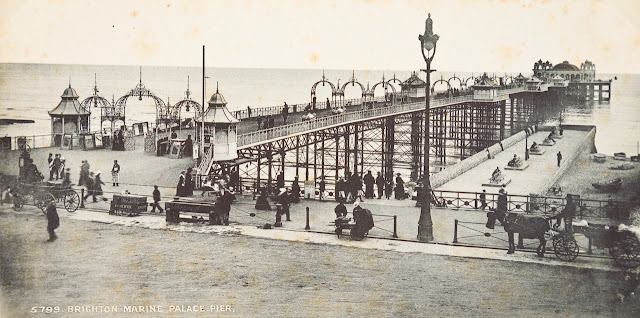Eugenius Birch - born this day in 1818 - was the preeminent engineer of the Victorian seaside, the man who shaped the silhouette of England’s pleasure piers - and few places reflect his legacy more vividly than Brighton. Though best remembered for designing the West Pier, his original involvement with the Palace Pier also left a mark on the seafront that endures to this day. It is worth noting that Brighton is the only location where TWO Eugenius Birch built/inspired piers can be captured in a single ground-level photograph.
Brighton in the mid-19th century was already a flourishing resort town, a fashionable destination for sea air and spectacle. But its early piers were practical structures - wooden jetties for landing boats, not leisure. The transformation of the pier into a promenade of popular entertainment was largely Birch’s doing.The West Pier, opened in October 1866, was his masterpiece. Commissioned by the West Pier Company and built at a cost of over £27,000, it was the first pier in Britain designed specifically for pleasure rather than docking. Birch employed his trademark screw-pile technique - iron piles twisted deep into the seabed - which made the structure both elegant and resilient. The West Pier featured cast-iron columns, graceful arches, gas lighting, and a central pavilion where orchestras performed to strolling visitors. It soon became a jewel of the Brighton shoreline, admired for its engineering and its social atmosphere.
The success of the West Pier inspired calls for a second pier, further east, to replace the ageing and storm-battered Chain Pier. In 1881, the newly formed Brighton Marine Palace and Pier Company invited Birch to draw up plans for a grander structure: what would eventually become the Palace Pier. His design envisioned a wide, iron-framed promenade extending over 1,000 feet into the Channel, crowned with entertainment pavilions and theatre space - a palace of amusement on the sea.
Construction began in November 1881, but progress was plagued by bad weather and delays. Birch, now in his sixties and nearing the end of his life, did not live to see it through. He died in January 1884, and the project stalled for several years after. When work resumed in earnest, the Palace Pier’s design was significantly revised under new engineers, though it retained Birch’s iron-pile foundations and the core idea of a leisure pier rather than a landing stage.The Palace Pier was finally opened in May 1899, fifteen years after Birch’s death. Though much of the decorative design and superstructure was reimagined, the engineering principles remained his. Its immense popularity through the 20th century - with its theatres, arcades, and fairground rides - owed much to the model first tested on the West Pier. Today, the West Pier, now skeletal after fires and storms, stands as a haunting but beautiful ruin, a tribute to Birch’s original vision; and The Palace Pier continues to thrive as one of Britain’s most visited free attractions.
Happy Birthday Eugenius Birch. Further information is readily available online, for example at Wikipedia, the National Piers Society and The Victorian Web. The modern photograph above was taken in 2020. The two Victorian-era photographs of the piers were published in my book Brighton & Hove Then & Now (The History Press, 2013) but originally sourced from the James Gray Collection with thanks to the Regency Society.



No comments:
Post a Comment